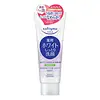What's inside
What's inside
 Key Ingredients
Key Ingredients

No key ingredients
 Benefits
Benefits

 Concerns
Concerns

 Ingredients Side-by-side
Ingredients Side-by-side

Dipotassium Glycyrrhizate
HumectantMyristic Acid
CleansingGlycerin
HumectantStearic Acid
CleansingPotassium Hydroxide
BufferingLauric Acid
CleansingPEG-7 Glyceryl Cocoate
EmulsifyingPPG-7 Lauryl Ether
EmollientSulfuric Acid
BufferingMilk Ferment
Skin ConditioningButylene Glycol
HumectantSodium Lauroyl Glutamate
Lauroyl Lysine
Skin ConditioningSilk Powder
Skin ConditioningGlycol Stearate
EmollientHydroxypropyl Methylcellulose
Emulsion StabilisingSodium Lauroyl Ethylenediamine Triacetate
Glyceryl Isostearate
EmollientAlcohol
AntimicrobialEthylparaben
PreservativeMethylparaben
PreservativeDipotassium Glycyrrhizate, Myristic Acid, Glycerin, Stearic Acid, Potassium Hydroxide, Lauric Acid, PEG-7 Glyceryl Cocoate, PPG-7 Lauryl Ether, Sulfuric Acid, Milk Ferment, Butylene Glycol, Sodium Lauroyl Glutamate, Lauroyl Lysine, Silk Powder, Glycol Stearate, Hydroxypropyl Methylcellulose, Sodium Lauroyl Ethylenediamine Triacetate, Glyceryl Isostearate, Alcohol, Ethylparaben, Methylparaben
Water
Skin ConditioningGlycerin
HumectantGlycylglycine
Butylene Glycol
HumectantHydroxypropyl Starch Phosphate
Cocamidopropyl Betaine
CleansingPEG-400
Emulsion StabilisingDecyl Glucoside
CleansingZinc Lauroyl Aspartate
Tea-Cocoyl Glycinate
CleansingSodium Stearoyl Glutamate
CleansingGlyceryl Stearate
EmollientHyaluronic Acid
HumectantHydroxypropyltrimonium Hyaluronate
Citric Acid
BufferingStearic Acid
CleansingLauric Acid
CleansingPEG-32
HumectantDisodium EDTA
Polyquaternium-7
Hydroxypropyl Methylcellulose
Emulsion StabilisingPolyquaternium-52
Methylparaben
PreservativePropylparaben
PreservativeBHT
AntioxidantWater, Glycerin, Glycylglycine, Butylene Glycol, Hydroxypropyl Starch Phosphate, Cocamidopropyl Betaine, PEG-400, Decyl Glucoside, Zinc Lauroyl Aspartate, Tea-Cocoyl Glycinate, Sodium Stearoyl Glutamate, Glyceryl Stearate, Hyaluronic Acid, Hydroxypropyltrimonium Hyaluronate, Citric Acid, Stearic Acid, Lauric Acid, PEG-32, Disodium EDTA, Polyquaternium-7, Hydroxypropyl Methylcellulose, Polyquaternium-52, Methylparaben, Propylparaben, BHT
 Reviews
Reviews

Ingredients Explained
These ingredients are found in both products.
Ingredients higher up in an ingredient list are typically present in a larger amount.
Butylene Glycol (or BG) is used within cosmetic products for a few different reasons:
Overall, Butylene Glycol is a safe and well-rounded ingredient that works well with other ingredients.
Though this ingredient works well with most skin types, some people with sensitive skin may experience a reaction such as allergic rashes, closed comedones, or itchiness.
Learn more about Butylene GlycolGlycerin is already naturally found in your skin. It helps moisturize and protect your skin.
A study from 2016 found glycerin to be more effective as a humectant than AHAs and hyaluronic acid.
As a humectant, it helps the skin stay hydrated by pulling moisture to your skin. The low molecular weight of glycerin allows it to pull moisture into the deeper layers of your skin.
Hydrated skin improves your skin barrier; Your skin barrier helps protect against irritants and bacteria.
Glycerin has also been found to have antimicrobial and antiviral properties. Due to these properties, glycerin is often used in wound and burn treatments.
In cosmetics, glycerin is usually derived from plants such as soybean or palm. However, it can also be sourced from animals, such as tallow or animal fat.
This ingredient is organic, colorless, odorless, and non-toxic.
Glycerin is the name for this ingredient in American English. British English uses Glycerol/Glycerine.
Learn more about GlycerinThis ingredient is a semi-synthetic polymer created from cellulose. In case you need a refresher, cellulose is the main component of plant cell walls.
Hydroxypropyl Methylcellulose has many uses:
- emulsifier
- create a gel-like texture
- boost foam
Lauric Acid is a fatty acid or lipid. About half of fatty acids in coconut oil is lauric acid.
This ingredient helps hydrate and sooth skin. As a humectant, it helps trap moisture. It also aids in cleaning and enhancing the texture of products.
Lauric acid may not be Malassezia folliculitis, or fungal acne, safe.
Learn more about Lauric AcidMethylparaben is a preservative and is a paraben. It is used to prevent the growth of fungus, mold, and other harmful bacteria. Parabens are chemicals used as preservatives in both cosmetics and food.
Methylparaben can be synthetically created. It can also be found naturally in some fruits, such as blueberries.
Oftentimes, Methylparaben is combined with other parabens to help increase the shelf life.
The safety of Methylparaben is currently being studied. While ongoing studies are looking into the safety of parabens, the results have been very mixed. Some studies have not found Methylparaben to be harmful.
Learn more about MethylparabenStearic Acid is a fatty acid. It is an emollient, emulsifier, and texture enhancer.
As an emollient, stearic acid helps soften skin. It aids the skin's protective barrier by preventing water loss. It also provides a gentle cleansing effect without stripping away natural oils.
Stearic acid may also be used to enhance the texture of products. It can add volume and stabilize ingredients such as water and oil. This can help water and oil ingredients from separating.
Sources of stearic acid include animal or vegetable fats/oils such as coconut or shea. It can be naturally found in butter, cocoa butter, shea butter, vegetable fats, and animal tallow.
This ingredient may not be Malassezia folliculitis, or fungal-acne safe.
Learn more about Stearic Acid